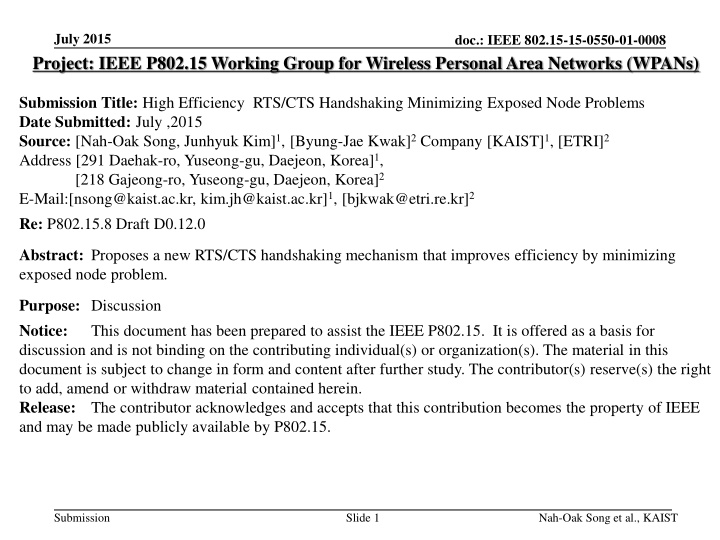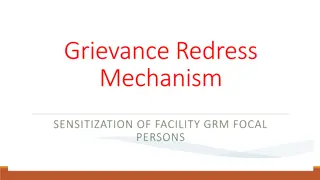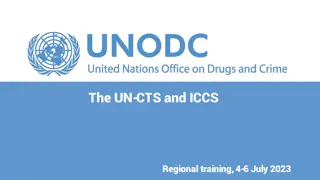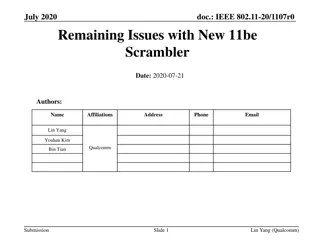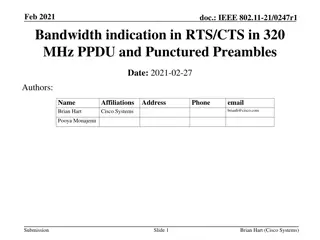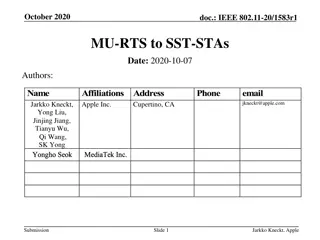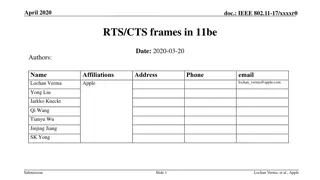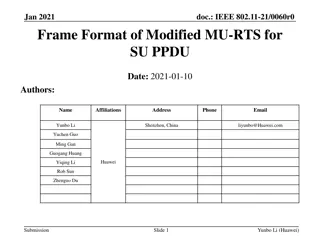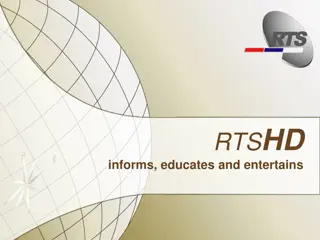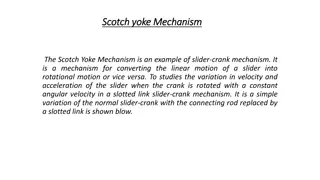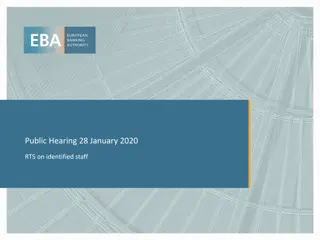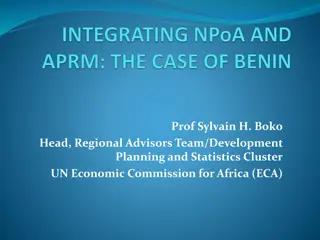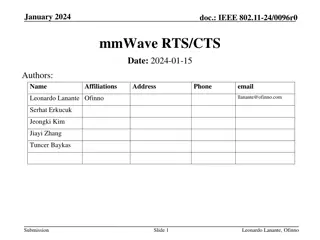High Efficiency RTS/CTS Handshaking Mechanism
This document proposes a new RTS/CTS handshaking mechanism to improve efficiency by minimizing the exposed node problem. The communication range, terminology, and proposed mechanism are discussed in detail.
Download Presentation

Please find below an Image/Link to download the presentation.
The content on the website is provided AS IS for your information and personal use only. It may not be sold, licensed, or shared on other websites without obtaining consent from the author.If you encounter any issues during the download, it is possible that the publisher has removed the file from their server.
You are allowed to download the files provided on this website for personal or commercial use, subject to the condition that they are used lawfully. All files are the property of their respective owners.
The content on the website is provided AS IS for your information and personal use only. It may not be sold, licensed, or shared on other websites without obtaining consent from the author.
E N D
Presentation Transcript
July 2015 Project: IEEE P802.15 Working Group for Wireless Personal Area Networks (WPANs) doc.: IEEE 802.15-15-0550-01-0008 Submission Title: High Efficiency RTS/CTS Handshaking Minimizing Exposed Node Problems Date Submitted: July ,2015 Source: [Nah-Oak Song, Junhyuk Kim]1, [Byung-Jae Kwak]2 Company [KAIST]1, [ETRI]2 Address [291 Daehak-ro, Yuseong-gu, Daejeon, Korea]1, [218 Gajeong-ro, Yuseong-gu, Daejeon, Korea]2 E-Mail:[nsong@kaist.ac.kr, kim.jh@kaist.ac.kr]1, [bjkwak@etri.re.kr]2 Re: P802.15.8 Draft D0.12.0 Abstract: Proposes a new RTS/CTS handshaking mechanism that improves efficiency by minimizing exposed node problem. Purpose: Discussion Notice: discussion and is not binding on the contributing individual(s) or organization(s). The material in this document is subject to change in form and content after further study. The contributor(s) reserve(s) the right to add, amend or withdraw material contained herein. Release: The contributor acknowledges and accepts that this contribution becomes the property of IEEE and may be made publicly available by P802.15. This document has been prepared to assist the IEEE P802.15. It is offered as a basis for Submission Slide 1 Nah-Oak Song et al., KAIST
July 2015 doc.: IEEE 802.15-15-0550-01-0008 High Efficiency RTS/CTS Handshaking Minimizing Exposed Node Problems July 2015 IEEE 802.15 Plenary Submission Slide 2 Nah-Oak Song et al., KAIST
July 2015 doc.: IEEE 802.15-15-0550-01-0008 Terminology NAV The network allocation vector (NAV) is a virtual carrier-sensing mechanism. [ ] The MAC layer frame headers contain a duration field that specifies the transmission time required for the frame, in which time the medium will be busy. The stations listening on the wireless medium read the duration field and set their NAV, which is an indicator for a station on how long it must defer from accessing the medium. (Source: Wikipedia) Submission Slide 3 Nah-Oak Song et al., KAIST
July 2015 doc.: IEEE 802.15-15-0550-01-0008 Communication Range (1) R_control : comm. range of control packet such as RTS, CTS, ACK R_data : comm. range of data packet ( R_control ) R_carrier : carrier sensing range (assume R_carrier = R_control) R_data : Comm. Range of Data Packet R_control : Comm. Range of Control Packet Comm. Area of Data Packet Comm. Area of Control Packet = Carrier Sensing Range PAC Device Submission Slide 4 Nah-Oak Song et al., KAIST
July 2015 doc.: IEEE 802.15-15-0550-01-0008 Communication Range (2) Case 1: the sender and the receiver are closely located High transmission rate can be chosen, reducing the communication range Sender Receiver Sender Receiver Comm. Area of Data Packet Comm. Area of Control Packet (ACK) Submission Slide 5 Nah-Oak Song et al., KAIST
July 2015 doc.: IEEE 802.15-15-0550-01-0008 Communication Range (3) Case 2: the sender and the receiver are not closely located Low transmission rate is chosen, making the communication range long Sender Receiver Sender Receiver Comm. Area of Data Packet Comm. Area of Control Packet (ACK) Submission Slide 6 Nah-Oak Song et al., KAIST
July 2015 doc.: IEEE 802.15-15-0550-01-0008 Original RTS/CTS Handshaking NAV Setting Mechanism RTS CTS DATA ACK PDRTS NAV(RTS) PDCTS NAV(CTS) Receiver Sender Comm. Area of CTS Sender Receiver Comm. Area of RTS Submission Slide 7 Nah-Oak Song et al., KAIST
July 2015 doc.: IEEE 802.15-15-0550-01-0008 Proposed RTS/CTS Handshaking (1) Original RTS/CTS handshaking Removes hidden nodes Instead, creates more exposed nodes Thus, results in inefficient use of valuable resource Proposed RTS/CTS handshaking Minimizes exposed nodes created by the original RTS/CTS handshaking By smart NAV setting mechanism Submission Slide 8 Nah-Oak Song et al., KAIST
July 2015 doc.: IEEE 802.15-15-0550-01-0008 Proposed RTS/CTS Handshaking (2) When RTS is sent: PDs in the comm. range of RTS (PDRTS) set NAV for the duration of CTS RTS CTS DATA ACK PDRTS NAV(RTS) R_data : Comm. Range of Data Packet R_control : Comm. Range of Control Packet Comm. Area of RTS Control Packet Sender Receiver Submission Slide 9 Nah-Oak Song et al., KAIST
July 2015 doc.: IEEE 802.15-15-0550-01-0008 Proposed RTS/CTS Handshaking (3) When CTS is sent: PDs in the comm. range of CTS (PDCTS) set NAV for the duration of DATA RTS CTS DATA ACK PDRTS NAV(RTS) PDCTS NAV(CTS) Receiver Sender Receiver Sender Submission Slide 10 Nah-Oak Song et al., KAIST
July 2015 doc.: IEEE 802.15-15-0550-01-0008 Proposed RTS/CTS Handshaking (4) When Data packet is sent: PDs receiving data packet (PDData) sets NAV for duration of ACK RTS CTS DATA ACK PDRTS NAV(RTS) PDCTS NAV(CTS) NAV(DATA) PDDATA Sender Receiver Sender Receiver Submission Slide 11 Nah-Oak Song et al., KAIST
July 2015 doc.: IEEE 802.15-15-0550-01-0008 Proposed RTS/CTS Handshaking (5) NAV Setting Mechanism RTS CTS DATA ACK PDRTS NAV(RTS) PDCTS NAV(CTS) NAV(DATA) PDData(RP_th) Receiver Receiver Receiver Sender Comm. Area of DATA Sender Comm. Area of CTS Sender Comm. Area of RTS Submission Slide 12 Nah-Oak Song et al., KAIST
July 2015 doc.: IEEE 802.15-15-0550-01-0008 Conclusion There will be a lot of hidden and exposed node problems in PAC The original RTS/CTS handshaking solves hidden node problem, but creates more exposed nodes The proposed RTS/CTS handshaking is a simple way to minimize exposed node problem Submission Slide 13 Nah-Oak Song et al., KAIST
